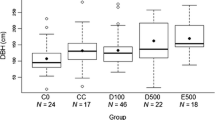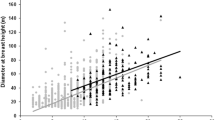Abstract
The detailed habitat utilization of the Shiga B2 troop was studied in winter. The following results were obtained. (1) The roosting site distribution was limited to the Yokoyugawa valley. (2) The measured home range size was 1.99 km2, which was greater than the 1.23 km2 of larger population size of the Shiga C troop. (3) The daily travel distance ranged from 0 to 1,825 m (mean 646 m). (4) The pendulum cycle of troop movement is composed of two types: wandering and tripping. The daily travel distance in tripping was much longer than that in wandering. (5) The utilization rate of the home range was assessed according to the total length of the travelling course per grid square. Highly utilized areas in the home range were found along the Yokoyugawa valley without using areas far from the valley. (6) Diurnal activity was influenced by climate, although it was difficult to establish any clear daily rhythm. (7) The food items amounted to 39 species. (8) Distribution of densely utilized sites of food resources almost coincided with those of resting sites. (9) The reasons for the use of the complete home range by the B2 were also discussed.
Similar content being viewed by others
References
Ashizawa, S., 1977. Japanese monkeys in the Shimokita Peninsula.The Nihonzaru, 3: 11–22. (in Japanese)
Azuma, S. &S. Ashizawa, in press. Habitat quality, home range size and population features in Shimokita Peninsula of Japanese monkeys.Proc. Sym. 7th Congr. Primatol. Soc.
Clutton-Brock, T. H., 1975. Ranging behavior of red colobus (Colobus badius tephrosceles) in the Gombe National Park.Anim. Behav., 23: 706–722.
Fossey, D., 1974. Observations on the home range of one group of mountain gorillas (Gorilla gorilla beringei).Anim. Behav., 22: 568–581.
Hayashi, K., 1970. Ecological studies of Japanese monkeys in Hakusan National Park-II. In:Scientific Studies of Hakusan National Park, Ishikawa-ken, pp. 344–375. (in Japanese)
Homewood, K. M., 1978. Feeding strategy of the Tana mangabey (Cercocebus galeritus galeritus) (Mammalia: Primates).J. Zool., 186: 375–391.
Iwamoto, T., 1978. The bioeconomic study on two primate populations, Gelada baboon (Thelopithecus gelada) and Japanese monkey (Macaca fuscata fuscata) with special reference to the limitation of their population density. D. Sc. Thesis, Kyushu Univ.
Izawa, K., 1971. Ecological study of wild Japanese monkeys living in Jadani valley, Hakusan Mountains. I—Inter-troop relationships through troop movements in snowy season (1).Ann. Rep. Hakusan Sci. Res. Comm., pp. 6–18. (in Japanese)
Koganezawa, M., 1975. Food habits of Japanese monkey (Macaca fuscata) in the Boso mountains. In:Contemporary Primatology,S. Kondo,M. Kawai &A. Ehara (eds.), S. Karger, Basel, pp. 380–383.
Maezima, K., I. Iwai &M. Yamanaka, 1977. Of the bacterial fauna in dung of Japanese monkeys in the Shiga Heights.Ann. Rep. Primat. Res. Inst., Kyoto Univ., 7: 39. (in Japanese)
Maruhashi, T., 1980. Feeding behavior and diet of the Japanese monkey (Macaca fuscata yakui) on Yakushima Island, Japan.Primates, 21: 141–160.
————, 1981. Activity patterns of a troop of Japanese monkeys (Macaca fuscata yakui) on Yakushima Island, Japan.Primates, 22: 1–14.
Nakayama, T., H. Hori, H. Tokura, F. Hara &M. Suzuki, 1975. Thermoequilibrium of the Jigokudani Japanese macaques in winter.Physiol. & Ecol., 16: 87–92. (in Japanese)
Suzuki, A., 1965. An ecological study of wild Japanese monkeys in snowy areas—focussed on their food habits.Primates, 6: 31–72.
————,K. Wada, S. Yoshihiro, E. Tokida, S. Hara &Y. Aburada, 1975. Population dynamics and group movement of Japanese monkeys in Yokoyugawa valley, Shiga Heights.Physiol. & Ecol., 16: 15–23. (in Japanese)
Wada, K., 1964. Some observations on the life of monkeys in snowy districts of Japan.Physiol. & Ecol., 12: 151–174. (in Japanese)
————, &Y. Ichiki, 1980. Seasonal home range use by Japanese monkeys in the snowy Shiga Heights.Primates, 21: 468–483.
Waser, P., 1977. Feeding, ranging and group size in the MangabeyCercocebus albigena. In:Primate Ecology,T. H. Clutton-Brock (ed.), Academic Press, London, New York & San Francisco, pp. 183–222.
Watanabe, T., 1975. Some features of the wild Japanese monkeys (Macaca fuscata) of Shiga A troop from viewpoint of somatometry.Physiol. & Ecol., 16: 55–63. (in Japanese)
Yotsumoto, N., 1976. The daily activity rhythm in a troop of wild Japanese monkeys.Primates, 17: 183–204.
Author information
Authors and Affiliations
About this article
Cite this article
Wada, K., Tokida, E. Habitat utilization by wintering Japanese monkeys (macaca fuscata fuscata) in the Shiga heights. Primates 22, 330–348 (1981). https://doi.org/10.1007/BF02381574
Received:
Accepted:
Issue Date:
DOI: https://doi.org/10.1007/BF02381574




